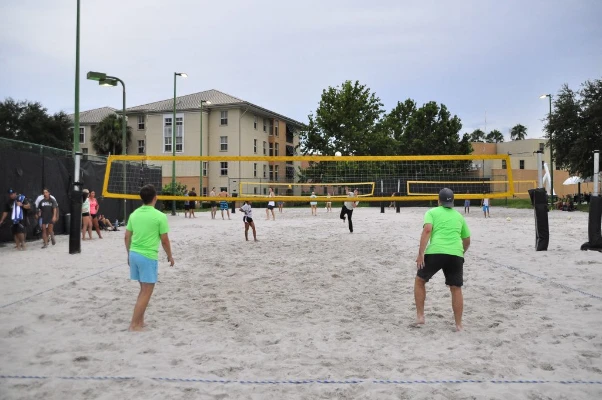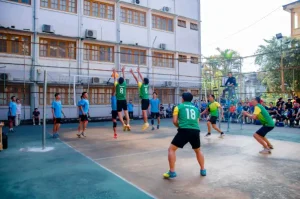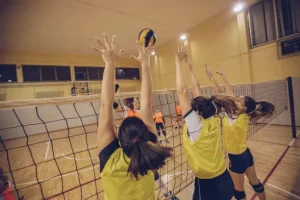Volleyball, linked with sun, sea, and relaxation, is a popular leisure and competitive activity. The particular charm of playing on a sand court makes the game challenging and fun.
Sand volleyball court is popular among players due to their size, structure, and unique features. This guide will cover them in detail.

Dimensions Of A Sand Volleyball Court
Sand volleyball courts adhere to standard dimensions set by governing bodies like the International Volleyball Federation (FIVB) and local associations. Consequently, these standardized dimensions provide a universal framework for consistent and fair play across different competitions and locations.
The key measurements for a traditional sand volleyball court are:
- Length: 16 meters (52 feet 6 inches)
- Width: 8 meters (26 feet 3 inches)
These dimensions mirror those of indoor volleyball courts, providing a consistent playing experience.

Sand Volleyball Court Surface
The defining feature of a sand volleyball court is, of course, the playing surface. The sand itself introduces a unique set of challenges and advantages for players. Here are some critical aspects of the court surface:
- Depth of Sand: The depth of the sand on a volleyball court is typically around 30 centimeters (12 inches). This depth contributes to shock absorption, making the impact on players’ joints less severe than on more challenging surfaces.
- Sand Composition: The type of sand used is crucial. Moreover, courts are typically filled with clean, fine-grain sand that provides sound footing for players. Commonly, beach volleyball courts use specially designed sand that ensures proper drainage and minimizes compacting.
Sand Volleyball Court Lines: Mapping the Territory
Like indoor courts, sand volleyball courts have specific lines that define the playing area and guide players. These include:
| Lines | Description |
|---|---|
| Boundary Lines | The outer edges of the court are marked by boundary lines. They establish the legal playing area and help determine whether a ball is in or out of bounds. |
| Centerline | Like indoor courts, sand volleyball courts have a centerline dividing the court into two halves. It’s essential for serving and player positioning. |
| Attack Lines | Attack lines, or 3-meter (10-foot) lines, run parallel to the centerline on either courtside. Additionally, Back-row players attack boundaries are clearly marked. |
Net And Antennae: Aerial Elements
The net set up on a sand volleyball court closely resembles that of indoor courts, with a few adaptations for outdoor play:
- Net Height: Men’s beach volleyball nets height are 2.43 meters (7 feet 11 5/8 inches), and women’s are 2.24 meters (7 feet 4 1/4 inches).
- Antennae: vertical rods 80 centimeters (2 feet 7 1/2 inches) above the net. Evaluate if the ball crosses the net within their limitations.
Player Positions And Strategies: Navigating The Sand
Playing on sand introduces a set of challenges that players must navigate. Furthermore, the soft, shifting surface demands different strategies and techniques. Here are some points:
- Movement and Balance: Players must adjust their movement and balance since sand is unstable. Movement and footwork must be quick and precise.
- Power and Precision: Serving and spiking on sand require balancing power and precision. Additionally, the sand absorbs some energy, underscoring the importance of executing well-placed and well-timed shots.
- Communication: Effective communication between teammates becomes even more crucial in the open, sandy environment. Players must stay connected and coordinate their movements to outsmart the opposition.
Maintenance And Care: Preserving The Playing Surface
A sand volleyball court is essential to ensure a consistent and safe playing surface. Regular upkeep includes:
| Aspect | Description |
|---|---|
| Raking | Regularly rake sand courts to level the surface and remove debris or foreign objects. |
| Watering | Depending on the type of sand used, courts may require occasional watering to prevent excessive drying and compacting. |
| Drainage | Proper drainage is vital to prevent water accumulation, which can affect the quality of the sand. |
Popular Beach Volleyball Tournaments: Showcasing the Best
Beach volleyball has become synonymous with thrilling tournaments held in picturesque locations worldwide. Additionally, games such as the FIVB Beach Volleyball World Championships and the Olympic beach volleyball events attract top athletes.
These events not only showcase outstanding skills but also captivate audiences with intense matches set against stunning beach backdrops.
FAQs
Unlike indoor volleyball’s hardcourt, two teams play beach volleyball on a sand court.
Masonry sand is an all-purpose sand. It is usually fine-graded for use in filling cracks in pavers. For this reason, many people consider it for volleyball courts.
The parallel attack line is positioned 3m from the center line on 18m x 9m indoor volleyball courts. In contrast, beach volleyball courts, measuring 16m x 8m, do not feature an attack line. This absence allows players the freedom to hit the ball from wherever they choose on the court. Additionally, the two sports diverge not only in court dimensions but also in their scoring systems.
Run on the beach, take slower steps, and move laterally on the sand to increase endurance outside of practice. Furthermore, Beach volleyball requires the correct gear for sand, activity, and sun.
Conclusion
In conclusion, sand volleyball courts offer a unique and engaging experience for players and spectators alike. The sun, sand, and fierce competition best describe the mood at a beach volleyball game.
Moreover, with its challenging terrain, strategic gameplay, and the unmistakable allure of beachside settings, this variant of volleyball captures the essence of sport, camaraderie, and the joy of play amidst the natural beauty of sandy shores.
Whether a seasoned player or a beach enthusiast, sand court volleyball promises an unforgettable fusion of athleticism and coastal enjoyment.
In essence, it transforms the ordinary game into an extraordinary beachfront spectacle, uniting skillful competition with the laid-back charm of seaside leisure.
Sand volleyball is entertaining whether you’re an expert or want to hang out at the beach. Next time you play beach volleyball, realize you’re engrossed in an exciting and dynamic activity.
Related Posts
How Tall Is A Men’s Volleyball Net
How Many Sets Are In A Volleyball Game
Measurements Of A Volleyball Court: Dimension, Net Height
How To Set Up A Volleyball Net
Can you wear basketball shoes in volleyball
Can you use your head in volleyball

Hassan Baig a former volleyball player, coach and Administrative At Volleyplan.com.
My name is Hassan Baig and I am a former volleyball player and coach. I have a passion for the sport and have dedicated my life to promoting it. I have worked with some of the best players in the game and have helped them achieve their full potential Read More









